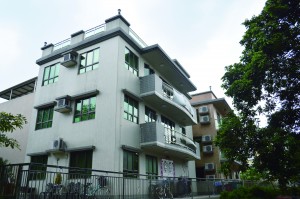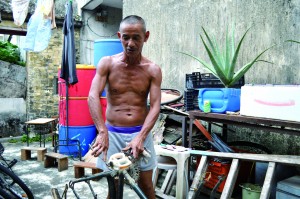Male indigenous villagers’ right to build small houses questioned in land-squeezed Hong Kong
By John Cheng and Antonia Wong
In August this year, television viewers were shocked to see a group of angry Lantau villagers hacking away at mangroves and even bringing in excavators to raze the lush green trees in an area that had been designated as a Site of Special Scientific Interest.
The villagers felt their rights to farm and build Small Houses, known as “ding houses”, were being trampled on by the government and vowed to fight to protect them. The incident drew attention to a long-standing issue in Hong Kong, the question of male indigenous villagers’ rights to build three-storey houses in the New Territories and whether the scheme is sustainable in land-strapped Hong Kong.
In 2012, the government revealed in a response to a lawmaker’s question about “vacant government land”, that 932 hectares of land had been reserved for “Village Type Development” while only 391.5 hectares were zoned for “Residential” or “Commercial/Residential” uses.

This led people to question whether the government was putting too many resources into developing rural areas – a move which would benefit indigenous male villagers since they have the right to build Small Houses.
The origin of ding rights dates back to 1972, when the colonial British government set up the Small House policy as a compromise with indigenous villagers to expropriate land in the New Territories to develop new towns.
Under the policy, a male indigenous villager aged at least 18 years old, who is descended through the male line from a resident of a recognised village in the New Territories in 1898, may apply once during his lifetime for permission to erect for himself a ding house on a suitable site within his own village. They can either apply for a free building licence to build a small house on their own land without paying a premium, or for government land at a concessionary premium.
In general, land for building ding houses is confined to areas within what are referred to as Village Environs (VE), which generally means a 300-feet radius surrounding a recognised village.
Consideration may also be given to an application if the site concerned lies outside a VE but is located within a ‘V’ zone, which encircles a recognised village and is larger than the 300 ft. village environs, provided that the ‘V’ zone concerned surrounds or overlaps with the VE.
The right to build a ding house seems to be a gift to male indigenous inhabitants which is unfair to non-indigenous villagers. But Lawrence Poon Wing-cheung, senior lecturer at City University’s Department of Architecture and Civil Engineering, suggests otherwise.
“Looking back at history, [you’ll see] this is not bestowed,” says Poon. “The indigenous inhabitants really did lose something during the development.” Poon explains that Britain rented the New Territories from the Qing government in 1898 under the Convention between Great Britain and China Respecting an Extension of Hong Kong Territory. At that time, the owners of the land in the New Territories were the indigenous inhabitants. Poon thinks it is reasonable to “return’” the land to them as compensation since the land originally belonged to their ancestors.
However, four decades after the policy was implemented, the population of indigenous villagers has grown, as has the demand for land on which to build Small Houses.
Under the current policy, the qualified indigenous villagers can only build their small houses within the ‘V’ zone and the environs of the extension area of their own village. In other words, even if the villager owns land outside his village, he cannot build his Small House there. “The government has given us an ultimate restriction by limiting the land. It won’t increase the size of ‘V’ zone even if it expropriates land for development,” says Tang Wah-ching, village head of Sik Kong Village at Tin Shui Wai.
Like many other villages in the New Territories, Sik Kong Village faces the problem of a shortage of land available for building Small Houses. Tang further explains the government resumed most of the land surrounding the village for the development of Tin Shui Wai.
Worse still, due to the huge number of applications, even if villagers privately own plots of land, they still need to wait for around seven years before they can build a small house. According to the Development Bureau in 2012, there were more than 10,000 applications for building Small Houses waiting to be processed.
Tang is frustrated at what he sees as urban dwellers’ misunderstanding that indigenous villagers are born with the privilege to build a house. “The name of the policy remains but the reality is gone,” says Tang.

Apart from land, money is another major concern for indigenous villagers. Sixty-something Wong Cheuk-kai has spent his entire life in Sha Po Village in Yuen Long. He says building a small house would cost more than one million dollars, which is definitely out of his reach.
With a lack of land and money, some indigenous villagers have found other ways to get something out of their ding rights – by selling them. Usually, the land in a village is owned by just a few indigenous villagers. These landowners tend not to transfer the land to their fellow villagers but instead cooperate with real estate developers to build housing estates and other residential complexes.
The developer buys land in the village from villagers who own the land and buys ding rights from those who do not own land. The developer then builds houses under the name of the villagers who sold their rights and resells the houses after paying the land premium. Both parties can profit from the money earned.
However, such developments may actually violate the law. Chu Hoi-dick, a member of the executive committee of environmental group Land Justice League, points out that selling ding rights to real estate developers is illegal because it violates the declaration made by indigenous villagers when they apply to build Small Houses.
The declaration clearly states the applicant should not enter into any arrangement or agreement with any person or persons to transfer, alienate, dispose of or otherwise deal with his rights.
Against this background, the government’s disclosure that it had set aside two and half times as much land for village-type development compared with other residential and commercial use sparked criticisms that it will further encourage the abuse of ding rights.
However, Bowie Hau Chi-keung, the chairman of the Sheung Shui District Rural Committee, thinks it is legitimate to cooperate with developers to sell Small Houses for profit. He says it is the villagers’ freedom to rent or sell their rights. “What’s wrong [with selling ding right]? If you don’t want to live in a Small House, just sell it to other people. Take it or leave it, it’s normal.”
Hau runs his own Small House business and has built more than 100 Small Houses in Sheung Shui by purchasing ding rights and land from other indigenous villagers. He says he will definitely continue to purchase land and build Small Houses.
While the older generation emphasise their inherited privileges, the new generation of indigenous villagers want to see a more sustainable mode of rural development. “Some [of the older indigenous villagers] just want to sell the land and get money…I don’t know if it’s a generation gap, but the older generation does not have this concept of sustainable development,” says Bacary Tang Kin-tat, a university student as well as an indigenous villager.
Tang hopes villagers can think in the collective interest of the whole village instead of focusing on individual interests.
To ease the problem of the shortage of land, City University’s Lawrence Poon Wing-cheong suggests the government should relax the plot ratio to allow the building of Small Houses of more than three storeys, or even build high-density residential buildings for indigenous villagers in exchange for their ding rights. He also suggests giving flats to eligible indigenous villagers, similar to the Home Ownership Scheme, instead of Small Houses. Nevertheless, green groups doubt if the relaxation of the plot ratio restriction is necessary and worry it may have a negative impact on the environment. Wick Leung Tak-ming, campaign officer of the Conservancy Association, points out that taller buildings will affect the view and the wind direction and a denser population would lead to pollution problems.
Chu Hoi-dick also thinks such alternatives would fail to solve the fundamental problem – the never-ending demand for Small Houses. He believes the solution is to eventually abolish the Small House policy.
“I’m against any form of continuation of the indigenous villagers’ special rights. Hong Kong people should not be divided into classes with different economic and political power any more…It’s harming Hong Kong’s overall interest,” Chu says.
Roy Ng Hei-man, assistant campaign manager of the Conservancy Association, thinks it would be difficult to abolish the Small House policy, but believes there are still things that can be done. Ng suggests the government should not draw up any more ‘V’ zones. By restricting the building of Small Houses within the current ‘V’ zones and village environs, ding rights will end eventually. In the end, he says, the government holds the cards.
The Conservancy Association’s Wick Leung Tak-ming says there should be more restrictions on and supervision of the applications process for Small Houses. For instance, the government should verify the indigenous identity of applicants itself rather than through village representatives. He strongly advises the government to compile data on the indigenous villagers who are eligible for Small Houses and the area of land involved for each village. Leung says that if the government could monitor more effectively, less land would be needed for Small Houses.
The Small House policy is a complicated issue that involves the interests of different stakeholders and seems to have no immediate solution. Until now, the government has failed to take any concrete action to tackle the problem. But Ng believes the government has the ultimate responsibility to decide the future development of the policy.
“The government is the ultimate gatekeeper,” says Ng.
Edited by Hilda Lee











































